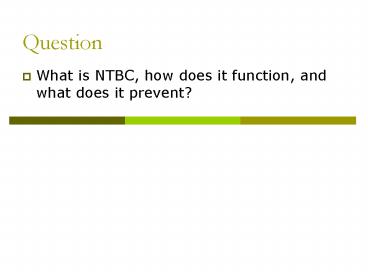Question PowerPoint PPT Presentation
1 / 31
Title: Question
1
Question
- What is NTBC, how does it function, and what does
it prevent?
2
Tyrosinemia
- Carolyn Jablonowski
3
Tyrosinemia
- Inborn error in the degradation of the amino acid
tyrosine. - Hereditary autosomally recessive.
- Three types (type I, type II, type III).
4
Tyrosine and Phenylalanine
- Tyrosine Phenylalanine
- Structures made by Carolyn Jablonowski
5
http//upload.wikimedia.org/wikipedia/commons/thum
b/a/a4/Autorecessive.jpg/180px-Autorecessive.jpg
6
Types of Tyrosinemia
- Type I deficiency of the enzyme
fumarylacetoacetate hydrolase (FAH). - Type II deficiency of the enzyme tyrosine
aminotransferase (TAT). - Type III deficiency of the enzyme
4-hydroxyphenylpyruvate dioxygenase (HPPD).
7
Type I Tyrosinemia
- Most common type of tyrosinemia.
- Caused by a mutation in the FAH gene that encodes
for the FAH enzyme. - Autosomally recessive
- Can be either chronic or acute.
- Acute infancy
- Chronic later in life
8
FAH gene
- Chromosome 15
- Contains 14 exons and extends 35kb long
- 34 mutations associated with HT1
- All effect normal activity of FAH.
9
Symptoms of Type I Tyrosinemia
- Failture to gain wieight or grow
- Diarrhea and vomiting
- Jaundice of skin and eyes
- Cabbage-like odor
- Increased tendency to bleed (esp. nosebleeds)
- Can lead to kidney and liver failure
- Liver cirrhosis and/or hepatocellular carcinoma
(chronic).
10
Fumarylacetoacetate Hydrolase
- FAH is the last in the series of five enzymes
needed to catabolize tyrosine. - Metalloenzyme
- Catalyzes the hydrolysis of 4-fumarylacetoacetate
to fumarate acetoacetate. - Deficiency of FAH results in accumulation of
succinylacetone, maleylacetoacetone, and
fumarylacetoacetate.
11
FAH Catalyzed Reaction
http//umbbd.msi.umn.edu/tyr/tyr_map.html
12
HT1
http//www.newbornscreening.info/Parents/aminoacid
disorders/Images/tyrosinemia_type1.gif
13
http//www.childrenshospital.org/newenglandconsort
ium/NBS/descriptions/images/tyro3.gif
14
Type II Tyrosinemia
- Caused by a mutation in the TAT gene that encodes
for the hepatic (liver) TAT enzyme. - Autosomally recessive
- Rare
- Also known as Richner-Hanhard syndrome
15
TAT gene
- Codes for tyr aminotransferase
- 10.9kb long
- Makes 454-AA protein weighing 50.4kDa.
- 12 exons
- 13 mutations associated with HT2.
16
Symptoms of Type II Tyrosinemia
- Elevated serum and plasma tyrosine levels also.
- Lesions of skin and eyes
- Due to clumping of cellular tyrosine crystals.
- Excessive tearing and abnormal sensitivity to
light (photophobia). - Mental retardation (caused by elevated blood
tyrosine levels) - Symptoms often begin in early childhood.
17
Tyrosine Aminotransferase
- TAT is the enzyme involved in the first of a
series of five reactions of tyrosine degradation. - In cytosol
- Pyridoxal 5-phosphate (PLP) dependent enzyme
- Transaminates tyrosine and
- a-ketogluterate into p-hydrophenylpyruvate and
glutamate. - Narrow substrate specificity
18
TAT Catalyzed Reaction
http//umbbd.msi.umn.edu/tyr/tyr_map.html
19
http//www.childrenshospital.org/newenglandconsort
ium/NBS/descriptions/images/tyro3.gif
20
Type III Tyrosinemia
- Caused by a mutation in the HPPD gene that
encodes for the enzyme HPPD. - Rare, autosomally recessive
- Deficiency of 4-hydroxyphenylpyruvate dioxygenase
(HPPD).
21
HPPD gene
- Located on 12q24-qter
- 14 exons
- HT3 and Hawkinsinura both affect this gene.
22
Symptoms of Type III Tyrosinemia
- Mild mental retardation
- Seizures
- Loss of balance and coordination (intermittent
ataxia). - High blood and urine concentrations of tyrosine
and HPP
23
4-Hydroxyphenylpyruvate Dioxygenase (HPPD)
- Second enzyme involved in tyrosine catabolism
pathway. - Non-heme iron oxygenase. Often forms dimers.
- Requires Fe(II), oxygen and a alpha-keto acid
substrate (typically alpha-ketoglutarate).
24
HPPD
http//www.uwm.edu/moran/images/HPPD.jpg
http//www.uwm.edu/moran/images/NTBC.jpg
25
Reaction Catalyzed by HPPD
http//umbbd.msi.umn.edu/tyr/tyr_map.html
26
http//www.childrenshospital.org/newenglandconsort
ium/NBS/descriptions/images/tyro3.gif
27
http//www.uwm.edu/moran/images/Tyrcatab.gif
28
Treatments
- Dietary restriction of tyrosine and
phenylalanine. (aim is below 500 µmol/L) - Treatement with NTBC (2-(2-nitro-4-trifluoro-methy
lbenzoyl)-1,3-cyclohexanedione) to block
metabolism. - Pro- Inhibitor of HPPD. NTBC structurally
similar to HPPD - Pro- Protects patients from fatal, end stages of
disease - Con- However, increases plasma tyrosine levels
and requires several follow-ups. - Liver transplant (popular in 1980s)
29
Inhibition of HPPD
http//www.uwm.edu/moran/images/Inhibitors.gif
30
Summary
- Tyrosinemia is an error in tyrosine catabolism.
- Three types of tyrosinemia (I, II, and III)
- Each is affect by a deficiency of a separate
enzyme - HT1 FAH
- HT2 TAT
- HT3 HPPD
- Treatments liver transplant, dietary
restriction, inhibitors (NTBC)
31
More information
- http//umbbd.msi.umn.edu/tyr/tyr_map.html

